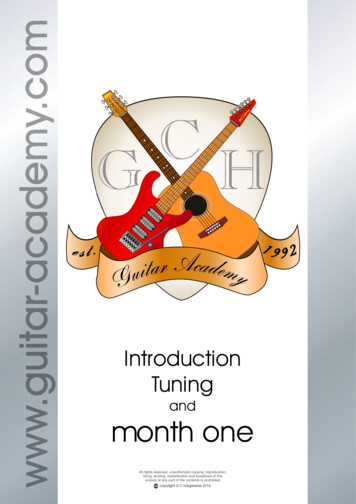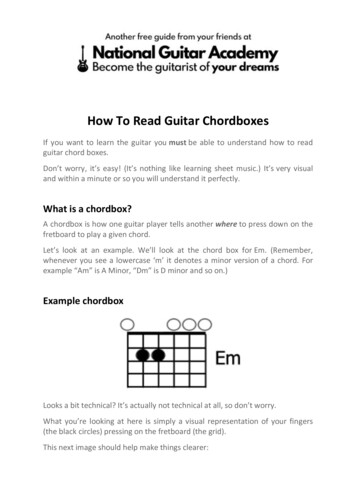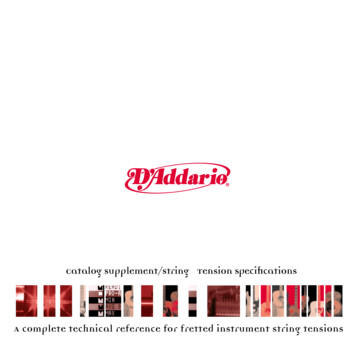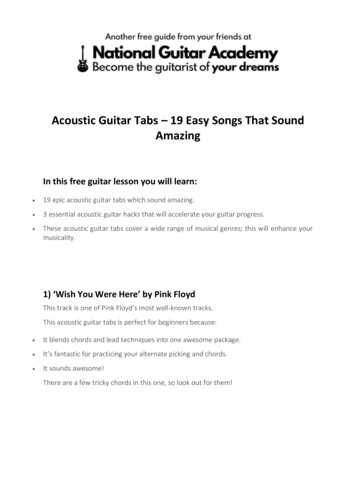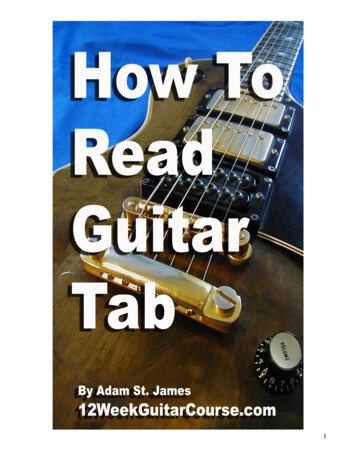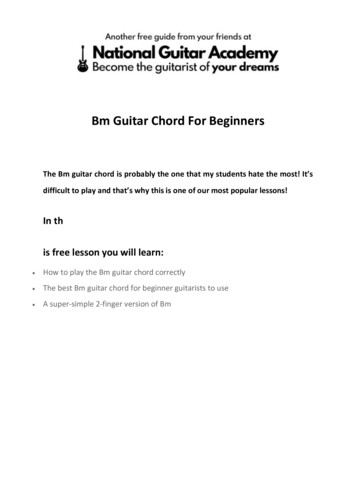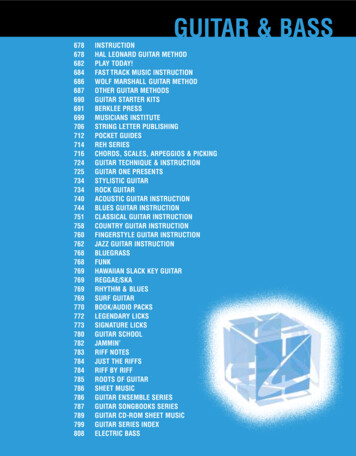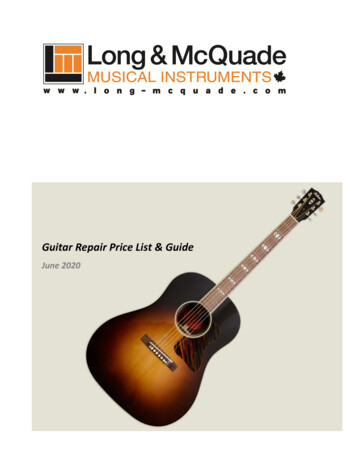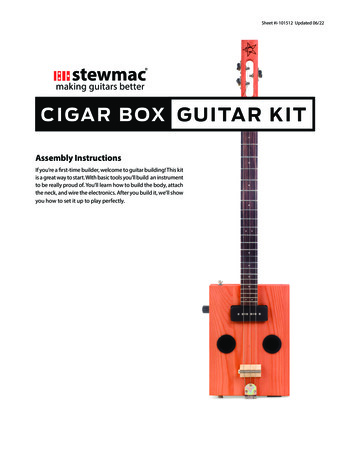
Transcription
Sheet #i-101512 Updated 06/22making guitars betterC IGAR B OX GUI TA R K I TAssembly InstructionsIf you’re a first-time builder, welcome to guitar building! This kitis a great way to start. With basic tools you'll build an instrumentto be really proud of. You’ll learn how to build the body, attachthe neck, and wire the electronics. After you build it, we’ll showyou how to set it up to play perfectly.
Table of contentsTools and supplies . . . . . . . . . . . . . . . . . . . . . . . . . . . . . . . . . . . . . 2Parts list . . . . . . . . . . . . . . . . . . . . . . . . . . . . . . . . . . . . . . . . . . . . . . . 3Getting started . . . . . . . . . . . . . . . . . . . . . . . . . . . . . . . . . . . . . . . . 4Prepping the neck . . . . . . . . . . . . . . . . . . . . . . . . . . . . . . . . . . . . 5Building the body . . . . . . . . . . . . . . . . . . . . . . . . . . . . . . . . . . . . . 8Fitting the hardware and electronics . . . . . . . . . . . . . . . . . . . . 10Initial setup . . . . . . . . . . . . . . . . . . . . . . . . . . . . . . . . . . . . . . . . . . . . 14Finishing . . . . . . . . . . . . . . . . . . . . . . . . . . . . . . . . . . . . . . . . . . . . . . 16Final assembly . . . . . . . . . . . . . . . . . . . . . . . . . . . . . . . . . . . . . . . . . 18Final setup . . . . . . . . . . . . . . . . . . . . . . . . . . . . . . . . . . . . . . . . . . . . 20Tools and suppliesThese are the tools and supplies we recommend for assembling this kit. StewMac item numbers are included whereapplicable.ToolsStraightedge (#4012)Rule (measurement starts at end) (#4905)Fretting hammer (#4895)Fret leveling tool (#4642 or #0862)Sanding block (#3701)Medium 3-corner file (#1602) or other fret crowning file (#6421)10mm wrench (#3691)Electric hand drillSoldering iron (#0502 or #0515)Screwdrivers: Phillips head #1 and #2 (#3000)Drill bits:1/16" (#1710)5/64" (#1712)3/32"(#1714)5/16"1/4" Countersink bitNut-slotting files:0.035" width (#0832)0.042" width (#0833)0.046" width (#5313)Optional:Clamps, 2 to 6 (#3704)SuppliesSandpaper: 120, 220, 320, 400, 600-grits (#5562)3M Polishing Papers (#6046)Masking tape (#0692)Light duty Scotch-Brite pad (#7445)Blue permanent markerTack clothOptional:Wood glue (Titebond Original, #0622)Glue brushes (#4167)Finishing suppliesThere are many finishes and application methods to choosefrom. We rely on ColorTone Aerosol Guitar Lacquers becausethey’re easy to use and you'll get a beautiful nitrocellulosefinish without investing in spray equipment.ColorTone Aerosol Guitar Lacquers:1 can Sanding Sealer (#3883)1 can of the color coat of your choice (optional)2-3 cans of Clear Satin Lacquer (#3882)
Parts listNeckNutTuners and bushingsStringsWire clipBridgeSaddle boltSound port ringsTruss rod wrenchBody topNeck blockTail blockNeckreinforcementblockBlock attachmentscrewsStrap buttonsBody backBack screwsJackL-bracketTailpieceP-90 pickupControl knobVolume control potNeck mounting screwsstewmac.com3
Getting startedThe cigar box guitar is a fun way to incorporate new soundsand styles into your playing. Traditionally a rough-and-readyhomemade electric instrument, now players from all genreshave been adopting its one-of-a-kind look and sound. Ifyou're looking to start playing slide, this is the perfect instrument for you!And, this is a very simple and unique build! You don't needproduction tools for building the body or neck—we've takencare of all the tricky parts. The kit is made for the small shopbuilder with a modest tool budget. You probably alreadyown most of what you'll need to build this guitar.First StepsWe strongly recommend you read all of this book before youstart building your kit. Understanding the later steps now willbe helpful to you as you start to build. Here's an outline ofthe build process to familiarize yourself with before diving-in:1. Prepping the neck2. Building the body3. Test fitting the hardware4. Finishing5. Final installation and setupDry BuildAs you build you can apply finish at different stages depending on what construction method you choose. For this buildwe recommend "dry building" (or test-fitting) all of the partsbefore painting. This is a good practice to be sure all of theparts, hardware, and electronics fit correctly and are placedexactly where you want them. It's easier to make adjustments and fix any mistakes before the body is painted withno unwanted surprises when you're done.Building Tips:1. Woods can be very fragile, so be careful. Always drill pilotholes to avoid splitting the wood. Always hand-tighten anyscrews to avoid stripping them out. A little patience goes along way.2. Mark all of your holes precisely using a scribe or mechanical pencil.3. Choose a drill bit that is smaller than the screw you areusing to make sure the screw will hold securely in the wood.4. Always use a depth-stop or piece of tape on the drill bitto mark how deep to drill your holes. It's easy to drill too far!6. If using glue at any step, always apply it in a thin layer. Remove any glue squeeze-out as it appears with a damp cloth.7. Use scrap wood cauls on both sides of the clamp jaws toprevent the clamps from denting the wood.8. Always test on scrap! Finish and glue drying time can varydepending on temperature and humidity of where you are.HumidityWhile you're probably excited to get started, you need totake a little time to acclimate your kit. Wood can be extremelysensitive to changes in humidity and temperature. The idealbuilding environment is 70-80 Fahrenheit (21-26 Celsius),with a controlled relative humidity of 45-50%. The woods inyour kit should be laid out and allowed to acclimate in yourspace for at least a few days before you start your build. Flipthe wood daily to neutralize excessive warping.Depending upon your location and the season, you mayneed to humidify or dehumidify your shop to maintainthe desired relative humidity. We advise you to purchase adecent quality thermometer/hygrometer to monitor yourshop's climate. Radical changes in humidity, especially during season changes, can cause warping, splitting, and otherserious complications. If you're unable to control the relativehumidity in your shop, we discourage building the guitarduring the transition from dry to wet seasons, or vice versa.You're going to put a lot of love into this build, and payingattention to the climate conditions while doing so is wellworth it.SafetyAlways use eye protection, and wear gloves when workingwith glues and chemicals. Read the labels of the productsyour are using and do several dry runs to make sure you arecomfortable with every step.Check your partsUnpack your kit and familiarize yourself with the parts bycomparing them to the included list. Inspect for any defectsor missing parts. Make note of the parts you are missing andlet us know as soon as possible—we'll make it right.Contact usWe wish you all the best on your build. If you get stuckor have any questions along the way, we're here tohelp! If you have any questions or concerns, contact:service@stewmac.com5. For very small screws, like tuner screws, wax the threadsbefore installation to prevent breaking the heads off.4stewmac.com
Prepping the neckThe frets come installed but will need a little attention dueto temperature and humidity change during manufactureand shipping. Seasonal changes can cause uneven frets andsharp fret ends. This is perfectly normal and very commonon every guitar. These steps will help you get them readyfor playing.Understanding the zero fretThis cigar box guitar uses a zero fret, located nearest the nutand headstock. The zero fret sets the height of the strings,and the nut sets the string spacing. The zero fret is intentionally higher than all of the other frets, do not sand it whenleveling or use it when measuring neck relief.zero fret Do not level or evaluate theneck using the zero fret.The idea is to use light taps, just enough to seat the frets flushto the fretboard. Hitting too hard can make a slight kink inthe fret that can cause the ends to spring and be difficult tore-seat. Using a heavy hand can also damage the fretboardby driving the fret down into it.After seating the frets with the hammer, check for any highspots across the frets—a short straightedge or a Fret Rockerworks well for this. Spanning three frets at a time, work downthe neck. If the tool rocks, you have a high fret. Level any highfrets you encounter with a file or Fret Kisser. Taking care ofthese high spots now will prevent your leveling tool fromhanging up on them when sanding and will give you a moreeven overall leveling job.Due to the natural expansion and contraction of unfinishedwood, it's normal for the frets ends to be a little sharp. Thisis part of routine maintenance for fretted instruments. Runyour fingers lightly along the edge of the fretboard andfeel for sharp fret ends. If the fret ends feel sharp wherethey meet the edge of the fingerboard, gently sand themback with 320-grit sandpaper using long strokes down thelength of the neck. Use care not to change the bevel of thefrets in the process.Seat the fretsUse a fretting hammer to make sure the frets are all seatedproperly. The more even your fret tops are, the less levelingwork there is to do later. Seating the frets at this point willalso help you more accurately straighten the neck whenusing a straightedge.With the hammer handle running parallel to the frets, startat one end of a fret and work your way across it using lighttaps that are square to the face of the hammer. Use care notto use the edge of the hammer head as it can cause a bendin the fret, making it difficult to seat properly.stewmac.com5
Straighten the neckUse the included 4mm Allen wrench to adjust the truss rod.With a straightedge on the frets, adjust the truss rod untilthe straightedge touches all of the fret tops without rocking.Please again note that the zero fret is slightly taller than therest. When checking the neck with a straightedge, sight theneck from the first fret on, staying off of the zero fret in orderto get an accurate reading.Turn the truss rod nut counterclockwise (viewed from thepeghead end) to loosen the truss rod, allowing the neck tobow upward. Go a quarter turn at a time, and wait for theneck to react. Turning it right tightens the rod, pulling theneck back.Level the fretsCigar box guitars can be set up to play two ways: with highaction to play with a slide, or with lower action to play withyour fingers on the fretboard: it's your choice. This section willshow you how to level the frets to play as a traditional guitar.Turn the truss rod nutcounterclockwise to bringthe neck up, adding relief.Measure string reliefat the 12th fret.If you are planning to play your cigar box guitar with aslide only, you can skip the level and crowning steps andgo straight to polishing.Color the length of the fret tops with a blue permanentmarker to prepare them for leveling. The marker ink will showyour progress: the frets are level when sanding has removedsome of the blue across all of the fret tops.Turn clockwise to pull theneck back, reducing relief.Go slow: a little does a lot!To learn more see our Trade Secrets article "Understandingguitar truss rod adjustment" at stewmac.com.stewmac.com search:6ts0338stewmac.com
The simplest way to level the frets is using a firm, flat blockwrapped in 320-grit sandpaper. There are a variety of levelingtools you can use, such as files and beams. Choose which ismost comfortable for you.Do not level the zero fret. The fretboard is flat, there is noradius to worry about then leveling. Level the frets by usingfull-length strokes down the fretboard, working from oneend to the other. Work slowly and check every few strokesto monitor your progress. The frets are level when the blueink is removed from the fret tops. The goal is to remove aslittle material as possible while still achieving a completelylevel fretboard.Crowning the fretsLeveling will leave flat tops on the frets which you will nowround over or "crown." Protect your fretboard from the filewith tape. Leave only the frets exposed and reapply bluemarker to the length of the fret tops.Use a fret crowning file to remove the hard edges createdby leveling and restore their rounded shape. File the sidesof the frets with a rounding motion until all that remains ofthe top is a very thin flat line along the center of the fret.Don't remove this line entirely, as filing the fret tops wouldundo your leveling. This line will buff out when polishing.To learn more see our Trade Secrets video "How to choosethe perfect fret crowning file" at stewmac.com.stewmac.com search:ts0327Polish the fretsTo remove the file marks, polish the frets using 400-gritsandpaper wrapped around a foam block and run up anddown the entire length of the fretboard. Repeat with 600grit sandpaper. Rounding the edge of the block will makepolishing easier. For a higher gloss there are a number ofdifferent options such as Scotch-Brite, 3M Polishing Papersor Micro-Mesh pads. When finished, remove the tape.stewmac.com7
Building the bodyYou will be doing a "dry build" where you will drill all thepilot holes and fit all the hardware before finishing. Refer tothe "Building Tips" section for helpful information on drilling pilot holes.Mark out the block attachment screwsThe neck and tail block will be secured to the body withtwo screws each. Two of these screws will also function asthe strap buttons, two are #6 x 1" block attachment screws.With the back temporarily placed on the body, determineyour hole locations, centered approximately 1-1/8" front toback and place them approximately 9/16" from the edge ofthe body as noted in the diagram.Strap buttonBlock attachment screwInstall the tail and neck blockAlign the neck and tail blocks inside the body. The tail blockalready has the jack hole drilled in it. Make sure to align thathole to the hole in the body. Also make sure to align the neckpocket in the body with the neck pocket in the neck block.If the neck block is out of alignment it will make installingthe neck difficult. Use tape to secure the blocks in placewhile drilling.Drill all four marked-out pilot-hole locations through thebody and neck and tail block. For the strap button holesuse a 5/64" drill bit, for the block attachment screws use a3/32" drill bit.Front of bodyStrap buttonBlock attachment screwNeck side9/16"9/16"1-1/8"1-1/8"Block attachment screw(3/32" bit)9/16"Strap button(5/64" bit)8To glue the blocks in, add a thin layer of glue to eachblock, and clamp them in the body in the locationsdescribed above. Use a padded clamp or scrap woodcauls on both sides of the clamp jaws to prevent themfrom denting the wood.Strap button(5/64" bit)Tailpiece side1-1/8"Option: You can also glue in the blocks and neck tothe body like a set neck or acoustic guitar. Gluing willmake a more solid connection, but will require moretools and time. If you will be using glue, you mustpaint the body and neck before building the body,they can't be disassembled after gluing.9/16"1-1/8"Block attachment screw(3/32" bit)stewmac.com
After drilling the pilot holes, first install the strap buttons,washers, and included screws using a #2 screwdriver.Then, for the remaining two block attachment screws, use a1/4" countersink bit and countersink the remaining two holelocations. Countersinking allows the head of screw clearancewhen tightened down without splitting the wood. Install thescrews using a #2 screwdriver.Install the L-bracketUsing the L-bracket as a guide, mark out the screw locationson the neck reinforcement block and the neck block. Drillthe two pilot holes 1/4" deep with a 5/64" bit using a pieceof tape or depth-stop. Install the L-bracket joining the backof the neck and the side of the body.Fit the neckInsert the neck into the body, face down. Seat it flat againstthe underside of the top and through neck pocket all theway to the pocket in the tail block.With the neck pressed firmly to the bottom of the body(through the tail block), and the neck reinforcement blockbutted firmly to the top of the body (through the neckblock), mark the locations of the 4 pre-drilled holes to theback of the neck.Remove the neck and drill the holes with a 5/64" drill bitrunning 3/8" deep. A 1/2" block of scrap wood placed underthe neck will help keep the neck level while drilling.Option: If gluing the neck in, spread a thin layer of glueon the neck below the pickup rout, fit the neck intothe body and clamp it in place. Use a padded clampor cauls. Your clamp will go through the pickup rout soit will contact the back of the neck and the top. Whendry, apply a thin layer of glue and attach the reinforcement block to the neck using the 4 included screws.Apply additional clamps if needed—the screws areusually enough to hold it in place. Wipe up any gluesqueeze-out.Re-install the neck and add the neck reinforcement block.Secure the screws using a #2 screwdriver. Go slowly andmake sure the holes are aligned.stewmac.com9
Fitting the hardware and electronicsIn this section you will be temporarily installing all of theparts and hardware to ensure a good placement and fit. Usea padded work surface to minimize any handling damage.Install the tunersThe bushings are installed from the inside of the peghead.Using finger pressure, fit the press-fit tuner bushings intothe holes leaving a fingernail's depth before they are flushwith the peghead. You will be removing them later beforefinishing.If they are not going in with finger pressure, use a small pieceof scrap wood as a caul for extra pressure to work them in.Go slowly and don't force it: too much pressure can splitthe peghead.Insert the tuners from the outside of the peghead, liningthem up squarely with the edge of the peghead. The knobsface the back of the guitar with the worm gear facing up.Mark out the locations of the screws and remove the tuners.Drill the pilot holes using a 1/16" bit, drilling 5/64" deep.Be careful and mark your depth on the bit with a piece ofmasking tape or depth-stop to prevent drilling all the waythrough the peghead wall.Important: Tuner mounting screws are very delicate and themahogany is hard. Lubricate the screw threads by draggingthem across soap or wax for smooth installation.With the tuners back in place, install the screws in the pilotholes with a #1 Phillips screwdriver.10stewmac.com
Install the nutAlign the nut on the neck. Mark out any nut material overhanging the sides of the neck with a pencil and remove itwith 320-grit sandpaper, bringing it in flush with the edgesof the neck. Install the nut with wood glue and tape in placewhile the glue dries. Make sure to leave space in the middle ofthe nut free of glue as to not interfere with the truss rod. Allyou need is just a tiny film of glue on the bottom of the nut.Wipe up any squeeze-out with a damp cloth before it dries.Drill for the volume control potYou will be fitting all of the electronics at this point to ensure a good fit; do not make the connections yet. That willbe done during final assembly after the body and neck arepainted and fully dry.The control pot can be positioned anywhere on the bodythin enough for it to fit. We suggest using the upper boutthrough the side, as the threaded collar that holds the potis not long enough to install the pot through the neck or tailblocks. Drill a 5/16" hole in the location you choose. Addingtape over the drilling location will minimize chipping outthe wood. Mark your depth so you won't go too far. The sidewood is very thin. Go slowly to avoid cracking the wood.When drilling be mindful not to drill into the neck or otherparts you can't see inside the body. Place the pot throughthe hole, and hand tighten the nut. Install the knob.Drill for the output jack screwsMark out the output jack screws location using the edgeof the body and jack plate to align it and to keep it square.Drill 5/16" deep holes using a 1/16" bit. Install the jack plate.Fit the pickupOrientation of this P-90 is not critical, but for easier wiring,install it so the side with the wires is closer to the volume pot.Using the pickup cover as your guide, mark out the pickupmounting screw holes. There may be wax in the holes youcan poke out with a 3/32" drill bit held with your fingers.Remove the pickup, and drill 1/2" deep pilot holes usinga 1/16" bit. Now insert the mounting screws through theholes in the pickup, and then thread the springs throughthe screws under the pickup. Lower the pickup into thecavity, aligning the screws with the drilled holes in the neck.Screw the pickup down so it is just lower than the end of thefingerboard, you will adjust the height later.stewmac.com11
Install the tailpieceLocate the center of the body at the tail end (a centeringrule is ideal for this), noting the centerline with a piece oflow-tack tape. Using the centerline, line up and mark out thetailpiece mounting screw locations with a pencil or a transferpunch. Do not drill on the top of the body. The hinge of thetailpiece faces up. You will be installing only three screws atthe base of the tailpiece. The three holes at the top are forinstalling the strings.Drill the top two holes 1/4" deep using a 5/64" bit. Thetailpiece will also house the ground wire. The bottom holewill be drilled all the way through. Later when installing theelectronics, this hole and tailpiece will secure the groundwire from inside the guitar.Fit the sound port ringsYou will need to enlarge the sound port holes for the ringsto fit. They should slide in with minimal pressure so as tonot crack the top. The rings will be glued in after finishing.Gently sand the inside of the sound port holes with 220-gritsandpaper until the ring is just held in place by the surrounding wood. Make sure to keep them round by sanding aroundthe hole evenly and checking the fit frequently.While supporting the back of the top with your fingers,carefully press the rings into place. Go slowly! You can crackthe top if you press too hard too fast. When the ring slidesin and out with minimal pressure, leave the ring installed.Install the backUsing the pre-drilled holes on the back of the body as aguide, mark out the attachment screw hole locations on theneck and tail blocks with a punch or pencil. Drill the pilotholes 1/2" deep with a 1/16" bit.After drilling, countersink the holes on the back of the bodywith a 1/4" countersink bit to allow the head of screw clearance without splitting the wood when tightened down.Attach the back using a #2 screwdriver.Now that all of the parts are temporarily installed, you willinstall the remaining hardware for a final fit check beforefinishing.12stewmac.com
stewmac.com13
Initial setupInstall the stringsLike a traditional guitar, the strings are installed from thickest to thinnest, with thickest string on the top, toward theceiling, and the thinnest on the bottom, towards the floor.Pull the strings through the bottom side of the tailpiece untilthe ball end catches on the hole. Then run the string up theneck and attach it to the tuner. An easy method is to wrap thestring around the tuner post twice, pull the excess throughthe hole in the post and tune up until tight. Leave the excessstring length so you can reuse the strings for final setup.Now move the straightedge down the fretboard so the endis now at the center of the 12th fret. Position the bridgeand bolt/saddle under the tape so that the second markyou made is in the center of the bolt/saddle. The bridge issymmetrical; either side will work when placing the bridge.The bridge will be very close to the tailpiece. This is normal.Don't tune them to final pitch. You want just enough tensionfor them to not be floppy.Position the bridge and saddleThis guitar has a floating (not attached) bridge that you willposition in the next step. The saddle is a threaded rod boltthat is secured to the bridge with string tension.Starting with the end of a straightedge at the center of thezero fret, and locate the center of the 12th fret. Put a piece oftape on the straightedge and mark the location of the centerof the 12th fret. This is half of the scale length.Make a second mark 1/8" past the 12th fret location youmarked towards the tailpiece.Adjust the neckWith the bridge in place, tune the strings to pitch. Standardcigar box tuning is low to high E-B-E, but we encourage youto experiment with others tunings to see what best suitsyour style.Using the provided hex wrench, adjust the neck relief withthe truss rod as described in the "Straighten the neck" section. Neck relief refers to adjusting a neck so that it has avery slight upbow, rather than being perfectly straight. Thisrelief allows a little more room for string vibration, reducingthe chance of hitting the lower frets and causing fret buzz.Turn the truss rod nutcounterclockwise to bringthe neck up, adding relief.Measure string reliefat the 12th fret.Turn clockwise to pull theneck back, reducing relief.Go slow: a little does a lot!Depending on your playing style, and how perfectly levelyour fret tops are, a neck should be anywhere from perfectlystraight to having 0.012" of relief. This measurement refersto additional string height over the 12th fret, compared toa perfectly straight neck. A straight neck tends to play andsound better, but very few guitars end up with no relief atall, and several thousandths of an inch or more is perfectlynormal.14stewmac.com
You can use a straightedge or the low E string to get you inthe ballpark. Using your index finger, hold down the low Estring at the first fret. With the other hand, hold down thestring at the fret where the neck meets the body with yourthumb and use your index finger to check for relief. Thesmaller the gap between the bottom of the string and thetop of the frets, the straighter the neck. For less relief, tightenthe truss rod, for more relief, loosen it.Evaluate and disassembleNow that the guitar is temporarily together, inspect yourwork. Inspect that all of the holes you drilled are locatedwhere you want, the tailpiece is centered, and the pickupmoves freely. It will be much easier (and look better) to makeany adjustments now before finish is applied.While the guitar is roughly setup, take some time to play it.Strum some chords and fret all of the notes on the fretboard.After finishing, you will be dialing in the setup further. Put astrap on it and play it in your normal playing position. Onceyou are happy with your work, carefully reverse the stepsand disassemble the guitar. You can leave the nut installed.stewmac.com15
FinishingThere are many options for finishing. A simple option thatcan be done indoors is a satin Wipe-on Poly or a rubbed-onoil finish. These dry quickly and will seal and protect thewood. If using a rubbed-on finish, follow the directions onthe package.Breaking the edgesWhile sanding, slightly break any sharp edges on the body,fingerboard, and peghead. Softening hard edges promoteseven finish coverage. Use a tack cloth to remove any remaining dust or debris.If you have the space and proper ventilation, we recommendhaving some fun with ColorTone Aerosols. They are a fastand easy way to get a beautiful nitrocellulose finish withoutinvesting in spray equipment.Degrease with naphthaWhen you've finished sanding, wipe the body and neck witha naphtha-dampened lint-free rag to remove any oils orgrease. From this point on, wear clean gloves when handlingso you won't contaminate the wood.Important finishing notes:For any type of finish, keep these precautions in mind. Don'tapply finish to any surface you'll glue, such as the inside ofthe body and base of the neck. Mask off the fretboard andtruss rod cavity to protect them from finish.Don't mix finish types (such as oil and nitro). These finishesare not compatible and mixing will result in a poor finalresult.Always test on scrap! Get your comfortable finishing technique before working on your guitar. Your drying time andfinal color can depend on the wood, temperature, and humidity where you are.Inspect the body and neck and repair any defects that younote, or not! Sometimes little bumps and bruises add character to this style of instrument. Small dents can be steamedout by placing a damp cloth over the dent and applying heatwith a soldering iron.To learn more, see our Trade Secrets video "Fixing a guitardent by steaming it out" at stewmac.com.stewmac.com search:Set up your finishing spaceLay down drop cloths or mask anything you do not want toget finish on. Make sure you have proper ventilation. Readthe labels of the products you are using and make sureyou have applicable safety gear like gloves, goggles, and arespirator mask.For spraying and drying, you can use a wire hanger throughthe hole in the bottom of the neck and through neck pocketor other-drilled holes in the body. Hanging the parts to drywill reduce the change of smudging the color coats andfinish as they dry.Mask the body and neckWhen finishing the neck, only finish the sides of the neck andheel up to the pickup rout and stop. Do not finish the insideof the body. Mask these areas with paper and tape. Mask offthe sides and top of the fretboard and the nut, truss rod nut,and truss rod cavity.ts0317No matter what finish you choose, preparing the neck andbody for finish is just as important as applying the finish.The key to a great looking finish is patience and lots of it.Prep work for any finishThere's no need to sand the inside of the body as it can beused as a gluing surface. Do not sand on the fret ends or tops,and do not change the bevel at the fret ends. No matter whatfinish you choose, follow these next steps for the best results.Sand the body and neckSand the body and neck using 320-grit sandpaper on asanding block. Sand only in the direction of the grain. Aftera complete sanding, wipe the body and neck with a dampcloth to raise the grain, to reveal fibers that need more sanding. Let the dampness dry, then sand the raised grain with320-grit sandpaper.16stewmac.com
S
The cigar box guitar is a fun way to incorporate new sounds and styles into your playing. Traditionally a rough-and-ready homemade electric instrument, now players from all genres have been adopting its one-of-a-kind look and sound. If you're looking to start playing slide, this is the perfect in-strument for you!
